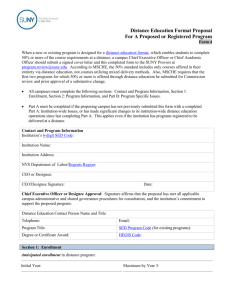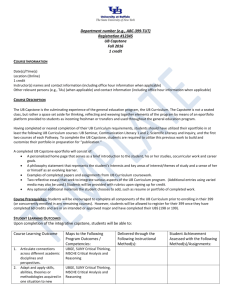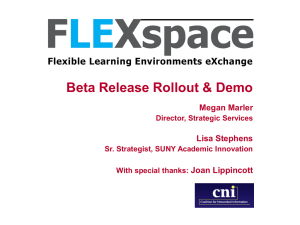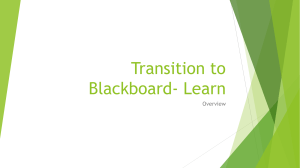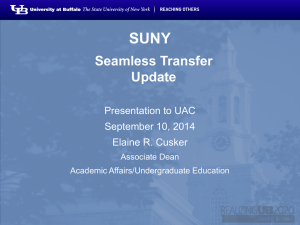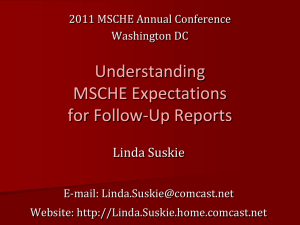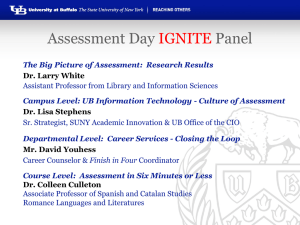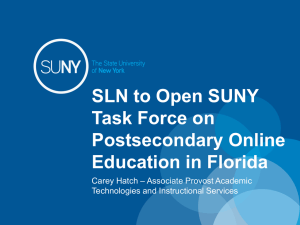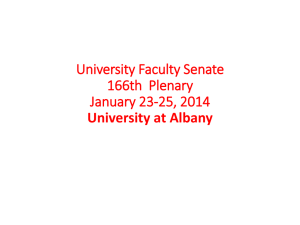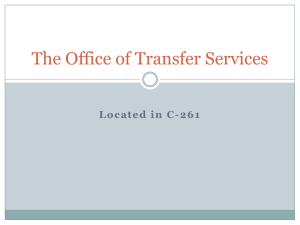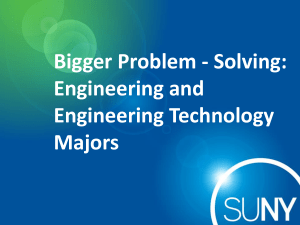MSCHE Standard 14 Assessment of Student Learning
advertisement
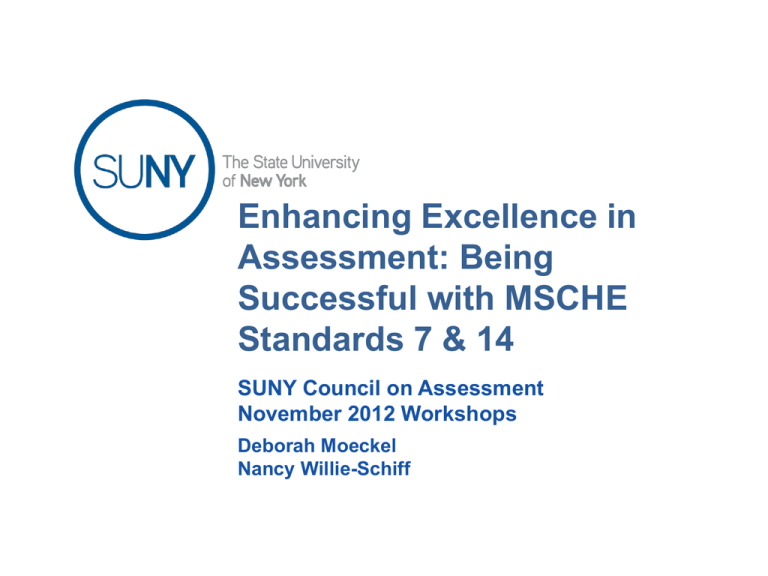
Enhancing Excellence in Assessment: Being Successful with MSCHE Standards 7 & 14 SUNY Council on Assessment November 2012 Workshops Deborah Moeckel Nancy Willie-Schiff SUNY Assessment Policy - 2010 Campuses expected to meet or exceed MSCHE’s standards by assessing: • general education (based on common SUNY SLOs) • academic programs at all levels (on a 5-7 year cycle, or with programmatic accreditation) • institutional effectiveness. http://www.suny.edu/provost/academic_affairs/assessment.cfm 2 Middle States Commission on Higher Education Characteristics of Excellence in Higher Education: Requirements of Affiliation and Standards for Accreditation (Updated 2011) http://www.msche.org/publications/CHX-2011-WEB.pdf 3 Crosswalk of Standards to Federal Regulations • One each for Standards 7 and 14. • Explains the source of each standard’s fundamental elements. • Produced by Middle States staff. 4 MSCHE Standard 7 Institutional Assessment The institution has developed and implemented an assessment process that evaluates its overall effectiveness in achieving its mission and goals and its Compliance with accreditation standards. FUNDAMENTAL ELEMENTS • documented, organized, and sustained assessment process to evaluate and improve the total range of programs and services; achievement of institutional mission, goals and plans; and compliance with accreditation standards that meets the following criteria: o a foundation in the institution’s mission and clearly articulated institutional, unit-level, and program-level goals that encompass all programs, services and initiatives and are appropriately integrated with one another; osystematic, sustained, and thorough use of multiple qualitative and/or quantitative measures that: maximize the use of existing data and information; clearly and purposefully relate to the goals they are assessing; 5 MSCHE Standard 7 Institutional Assessment FUNDAMENTAL ELEMENTS (continued) are of sufficient quality that results can be used with confidence to inform decisions; o support and collaboration of faculty and administration; o clear realistic guidelines and a timetable, supported by appropriate investment of institutional resources; o sufficient simplicity, practicality, detail, and ownership to be sustainable; o periodic evaluation of the effectiveness and comprehensiveness of the institution’s student learning assessment processes; • evidence that assessment results are shared and discussed with appropriate constituents and used in institutional planning, resource allocation, and renewal…to improve and gain efficiencies in programs, services and processes… • written institutional (strategic) plan(s) that reflect(s) consideration of assessment results. 6 MSCHE Standard 14 Assessment of Student Learning Assessment of student learning demonstrates that, at graduation, or other appropriate points, the institution’s students have knowledge, skills and competencies consistent with institutional and appropriate higher education goals. FUNDAMENTAL ELEMENTS • clearly articulated statements of expected learning outcomes, at all levels (institution, degree/program, course), and for all programs that aim to foster student learning and development… • documented, organized, and sustained assessment process to evaluate and improve student learning that meets the following criteria: o systematic, sustained, and thorough use of multiple qualitative and/or quantitative measures that: maximize the use of existing data and information; clearly and purposefully relate to the goals they are assessing; are of sufficient quality that results can be used with confidence to inform decisions; 7 MSCHE Standard 14 Assessment of Student Learning FUNDAMENTAL ELEMENTS (continued) include direct evidence of student learning; o support and collaboration of faculty; o clear, realistic guidelines and timetable, supported by appropriate investment of institutional resources; o support and collaboration of faculty; o sufficient simplicity, practicality, detail, and ownership to be sustainable; o periodic evaluation of the effectiveness and comprehensiveness of the institution’s student learning assessment processes; • assessment results that provide sufficient, convincing evidence that students are achieving key institutional and programmatic learning outcomes; • evidence that student learning assessment information is shared and discussed with appropriate constituents and is used to improve teaching and learning; and • documented use of student learning assessment information as part of institutional assessment. 8 Helpful Middle States Publications •Team Visits: Conducting and Hosting an Evaluation Visit (Appendix 1) • Assessing Student Learning and Institutional Effectiveness •Evaluating Student Learning Assessment processes (rubric) •Examples of Evidence of Student Learning •Follow up Reports and Visits •Summary of Actions a Team May Take 9 Resources for Campuses: Advantages of “Systemness” 10 http://www.suny.edu/provost/academic_affairs/assessment.cfm AND MUCH MORE… 11 http://www.suny.edu/provost/academic_affairs/RegAccred.cfm AND MUCH MORE… 12 SUNY Listservs Campus Assessment Contacts SUNYASSESSSO-L@ls.sysadm.suny.edu (STATE-OPERATED, INSTANT) SUNYASSESSCC-L@ls.sysadm.suny.edu ( COMMUNITY COLLEGES, INSTANT) SUNYASSESS-L@ls.sysadm.suny.edu (ALL CAMPUSES, WEEKLY DIGEST) Campus Accreditation Liaison Officers SUNYALOSO-L@ls.sysadm.suny.edu (STATE-OPERATED, INSTANT) SUNYALOCC-L@ls.sysadm.suny.edu (COMMUNITY COLLEGES, INSTANT) SUNYALO-L@ls.sysadm.suny.edu (ALL CAMPUSES, INSTANT) 13 http://www.sunyassess.org/index.html SUNY Council on Assessment (SCoA) • Enhances the assessment of institutional effectiveness and student learning by building, leading, and supporting a SUNY-wide assessment community that fosters collaboration, reduces duplication of effort and provides guidance and resources to campuses • Plans and leads professional development opportunities for faculty, staff and administrators in the area of assessment 14 http://www.oneonta.edu/anny/ Assessment Network of New York (ANNY) • Founded in 2010, as a private, non-profit professional association • Over 200 members by fall 2011, more than 60% from SUNY • Stimulates dialogue and the exchange of ideas related to assessment across MSCHE-accredited institutions and provides support and resources to those committed to meaningful assessment of student learning and institutional effectiveness • First Executive Board elected in June 2012 (11 members, 6 from SUNY, including 3 State Ops and 3 Community Colleges) • SERVICES: Listserv, Newsletter, Conference, Regional Workshops • Free, charter memberships still available 15 SUNY’s MSCHE Study Purpose • Assess SUNY progress toward goals • Inform campuses for improvement Data Sources • Documents from 41 MSCHE reviews in 2010 – 2012 • Decennial visits, follow ups & PRRs • Commission actions or team reports Method • Identify and classify each finding Caveats • No documents for a few additional reviews • Team reports not definitive 16 Distribution of 41 MSCHE Reviews in 2010 - 2012 by Type PRR, 20% Follow Up, 17% Decennial, 63% 17 Distribution of MSCHE's 621 Findings in 2010 - 2012 by Type Requirements, 4% Recommendations, 41% Commendations, 55% 18 Middle States Commission on Higher Education - Definitions Commendation: Significant accomplishments, significant progress, or exemplary/innovative practices. Suggestion: Non-binding Findings for Improvement. Recommendation: Institutional action needed for the institution to continue to meet the standards in Characteristics of Excellence in Higher Education. (Must be reported on in PRR or Monitoring Reports.) Requirement: Institutional actions needed to achieve compliance with the standard; “requirements” necessitate Commission action of postponement, warning, probation, or show cause. (Followed by additional monitoring reports and small team follow-up visit.) 19 Distribution of MSCHE's 341 Commendations in 2010 - 2012 by Standard 14% 12% 10% 8% 6% 4% 2% 0% 20 Number of Campuses with Commendations in 2010 - 2012 by Standard 25 20 15 10 5 0 21 Distribution of MSCHE's 254 Recommendations in 2010 - 2012 by Standard 25% 20% 15% 10% 5% 0% 22 Number of Campuses with Recommendations in 2010 - 2012 by Standard 30 25 20 15 10 5 0 23 Distribution of MSCHE's 26 Requirements in 2010 - 2012 by Standard 45% 40% 35% 30% 25% 20% 15% 10% 5% 0% 24 Number of Campuses with Requirements in 2010 - 2012 by Standard 9 8 7 6 5 4 3 2 1 0 25 Areas for Improvement for Standards 7 and 14 SETTING GOALS ● Use of SLOs for all programs and courses including graduate programs ● Goals for all functional units ● Incorporation of student learning outcomes in institutional effectiveness assessment PLANNING ● Formal assessment plan document ● Use of quantitative measures, direct measures, and data ● Alignment of all assessments (curriculum mapping) ● Staff and institutional support for assessment IMPLEMENTATION ● Culture of assessment/faculty engagement ● Communication of assessment results ● Closing the Loop ● Linking assessment to planning and budgeting ● Sustainability of assessment efforts and degree and consistency of implementation 26 Omnibus Requirements (10Q) and Recommendations (2R) •Appear most frequently in situations where: 1. assessment efforts appear random and inconsistent 2. evidence of assessment is lacking 3. the institution has been cited previously for assessment, and progress seems insufficient •Are most helpful in delineating all of the elements that an assessment plan and process need to indicate. 27 Sustainability of efforts, degree or consistency of implementation (18R) These recommendations are used primarily when assessment is underway, but: • the process is so complex or labor intensive that it cannot be sustained long term • the process is applied incompletely or inconsistently 28 Linking assessment to planning and budgeting (13R) and closing the loop (12R, 1Q) These recommendations tend to appear when: • assessment does not seem to be used to create institutional or departmental budgets • assessment does not appear to be used in strategic or unit planning The process is also especially important for academic planning: • implementation of new programs • elimination of programs 29 Alignment of all assessments, including curriculum mapping (12R, 5Q) Curricular and assessment alignment: clear linkages among student learning goals at the program, general education and course level. Some teams have looked for: • evidence that assessment of student learning outcomes specifically informs faculty grading policy • evidence that course syllabi contain this information 30 Development of SLOs for all programs and courses including graduate programs (6R) • ALL programs and courses must have clearly identified and published student learning outcomes (SLOs). • Program-level information must be available in catalogs and on websites. 31 Staff and institutional support for assessment (6R) These recommendations are primarily evident where: • there is no formal ownership of the assessment process in a particular organizational structure • various campus leaders are unresponsive to the need for their participation in assessment processes • appropriate assessment processes lack sufficient institutional research support • processes for assessment are particularly labor intensive 32 Use of quantitative measures, direct measures, and data (6R) • Use of multiple measures is recommended. • Quantitative measures in sufficient quantity must be used. • Direct measures of student learning must be included (as opposed to use of grades or surveys alone). 33 Communication of assessment results (6R) • These recommendations appear in situations where assessment results appear to be owned by a few people. • The need for access to these results for Boards of Trustees and College Councils has also been noted. • Communication of results is seen as an important part of linking assessment with planning and budgeting. 34 Goals for all functional units – administrative assessment (5R) • Implement assessment of all college services. • All offices including Business Offices, Financial Aid, Public Safety, Human Resources, among others, should have documented unit goals and assessment plans. 35 Culture of assessment/faculty engagement (5R, 1Q) • Some recommendations have indicated a need for all faculty to be actively engaged in assessment activities. 36 Incorporation of student learning outcomes in institutional effectiveness assessment (5R) • The primary purpose of Standard 7 is to assess whether or not an institution is meeting its mission and goals. Since the primary mission of any institution of higher education is student learning, these outcomes are considered to be appropriate to this standard. 37 Formal assessment plan document (3R, 1Q) The assumption that ‘everybody knows’ what needs to be done for assessment and what the processes are isn’t enough. Need a document which outlines: • all of the processes and how they fit together, • who is responsible, • what measures are being used, • what the timeline is, and • how the results have been used for improvement. See the omnibus recommendations and requirements for more detail on what these plans should include. Also helpful is the SUNY Memorandum to Presidents 2010-02 on the SUNY Website. 38 Questions? Comments and suggestions welcomed! Deborah.Moeckel@suny.edu Nancy.Willie-Schiff@suny.edu 39
